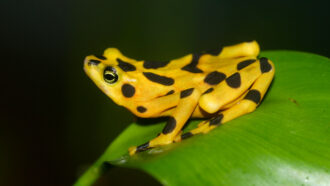In the 1990s and 2000s, Costa Rica and Panama experienced spikes in malaria cases. The massive loss of amphibians in the region from a deadly fungal disease may have contributed to the uptick of this human disease.
The spread of the fungal disease chytridiomycosis was a slow-motion disaster, leading to a decades-long wave of amphibian declines globally. From the 1980s to the 2000s, the wave moved from northwest to southeast across Costa Rica and Panama, hitting different places at different times. An analysis of local ecological surveys, public health records and satellite data suggests a link between the amphibian die-offs and an increase in human malaria cases as the wave passed through, researchers report in the October Environmental Research Letters.
Teasing out ways that biodiversity loss “ripple[s] through ecosystems and affect[s] humans” can help make a case for preventive actions in the face of other ecological threats, says Michael Springborn, an environmental economist at the University of California, Davis.
On average, each county in Costa Rica and Panama had 0.8 to 1.1 additional cases of malaria per 1,000 people per year for about six years, beginning a couple of years after the amphibian losses, Springborn and colleagues found.
Other research suggests that amphibians serve as important checks on mosquito populations. Amphibian larvae eat mosquito larvae, and the animals compete with each other for resources, such as places to live.
So the missing frogs, toads and salamanders may have led to more mosquitoes and potentially more malaria transmission. But it’s unclear whether mosquito populations actually increased during this time, Springborn says, because those data don’t exist.
Chytridiomycosis, caused by the fungus Batrachochytrium dendrobatidis or Bd, has led to the largest recorded loss of biodiversity due to a disease. It’s caused the decline of at least 500 species globally (SN: 3/28/19). Ninety of those species are presumed extinct. Frogs and toads in the Americas and Australia have suffered the greatest declines. The international trade in amphibians has spread the fungus globally.
Springborn and colleagues wondered if the impacts of the amphibian losses stretched to humans too. The researchers turned to Costa Rica and Panama, where the fungus moved through ecosystems in a somewhat uniform way along the narrow strip of land on which the two countries sit, Springborn says. This meant that the researchers could work out when the fungus arrived at a given place. The team also looked at the number of malaria cases in those places before and after the amphibian die-offs.
In the first couple of years after the animals’ decline, malaria cases started to rise. For the following six years or so, cases remained elevated, then started to go down again. The researchers aren’t sure yet what was behind the eventual drop.
Studies on the connections between biodiversity loss and human health might “help motivate conservation by highlighting the direct benefits of conservation to human well-being,” says Hillary Young, a community ecologist at the University of California, Santa Barbara who was not involved in the work.
“Humans are causing wildlife to be lost at a rate similar to that of other major mass extinction events,” she says. “We are increasingly aware that these losses can have major impacts on human health and well-being — and, in particular, on risk of infectious disease.”


